
Starting next year, we’ve been given a new National Holiday! It falls on Feb 1, which is celebrated as St Brigid’s Day in Ireland. (Also Imbolc but that’s another story.) Although in my far-off youth I had a devotion to St Brigid and took her name as my Confirmation Name (is this just a Catholic thing?) I realised I knew very little about Brigid herself. So I set out to do some digging, using my own photographs of her image in stained glass to illustrate. That’s Harry Clarke’s take on Brigid above, from the Honan Chapel in Cork, and another one of his below, from Castletownshend.
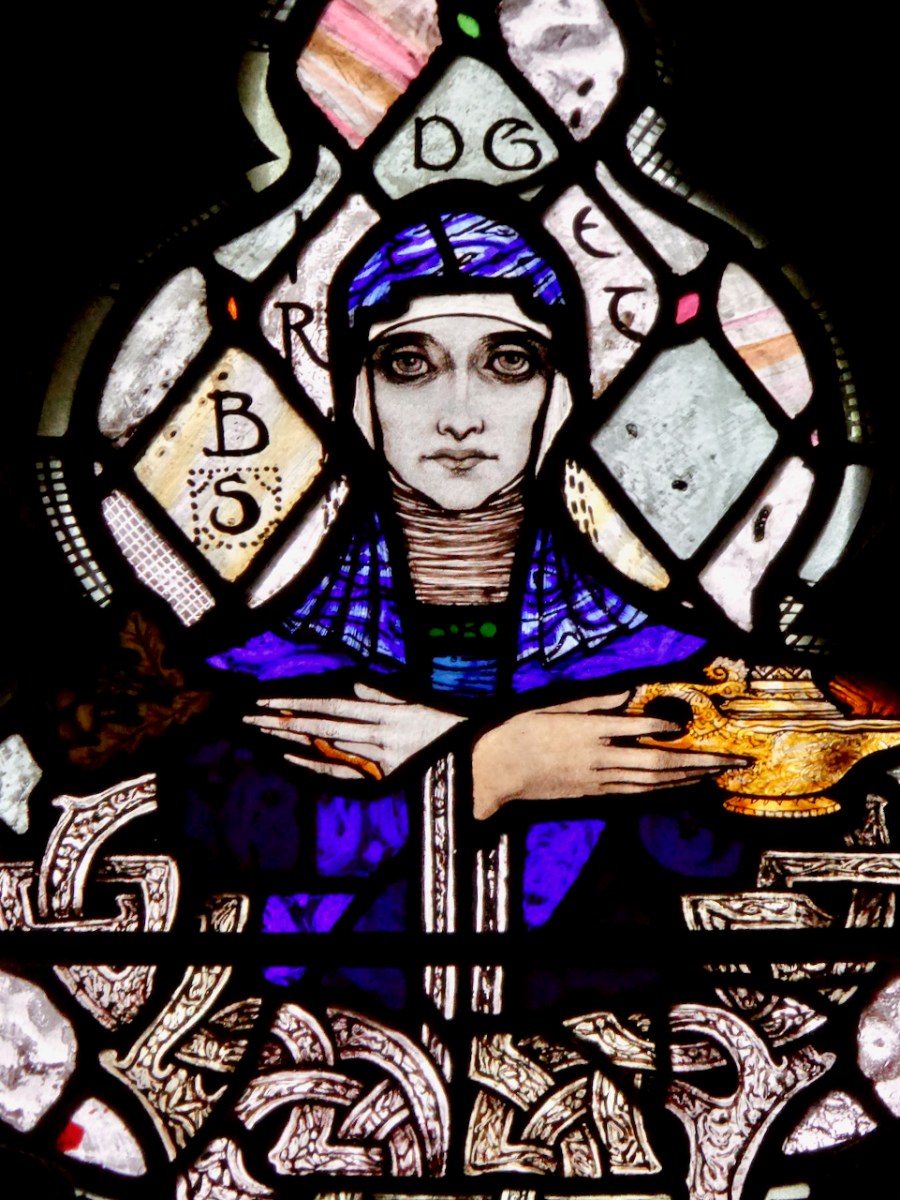
Note the lamp, which is one of her attributes, since she is associated with a perpetual fire that miraculously never went out. Given this is Harry Clarke, the lamp looks suspiciously like something from the Arabian Nights.
For the life of Brigid, although there are many, many versions, I have turned to two sources. The primary source is The Life of Saint Brigit by Cogitosus*. Almost unbelievably, this Life dates from about 650 and is written in Hiberno-Latin. Cogitosus may have been a monk in Kildare, steeped in the cult of Brigid. Part of this cult was to claim the highest status for Kildare of all the Irish monastic settlements and therefore the Primacy over all Ireland – a claim that was eventually won by Armagh, which trumped Kildare by its appropriation of St Patrick. Cogitosus’s story is told in the form of 32 miracles, each of which leads us through Brigid’s life.

Instead of an image of the saint, this window by George Walsh focusses on the Brigid’s Cross, another of her attributes, based on a story where she picked up rushes from the floor and wove them into a cross which healed a dying man. We like to make them every St Brigid’s Day and then hang them in the house to prevent damage by fire
My second source is the Life of Brigit from the Book of Lismore**, translated by Whitley Stokes. I love Stokes’s language, a form which he seems to have invented himself to convey something of the Medieval Irish he was translating (see this post on The White Hound of Brigown for more on this). The Book of Lismore dates to the fifteenth century and it is thought that the Lives of the Saints within it, or some of them, were written in the Abbey at Timoleague in West Cork. In both versions her name is given in translation as Brigit, rather than Brigid which is the more usual modern spelling used in Ireland.
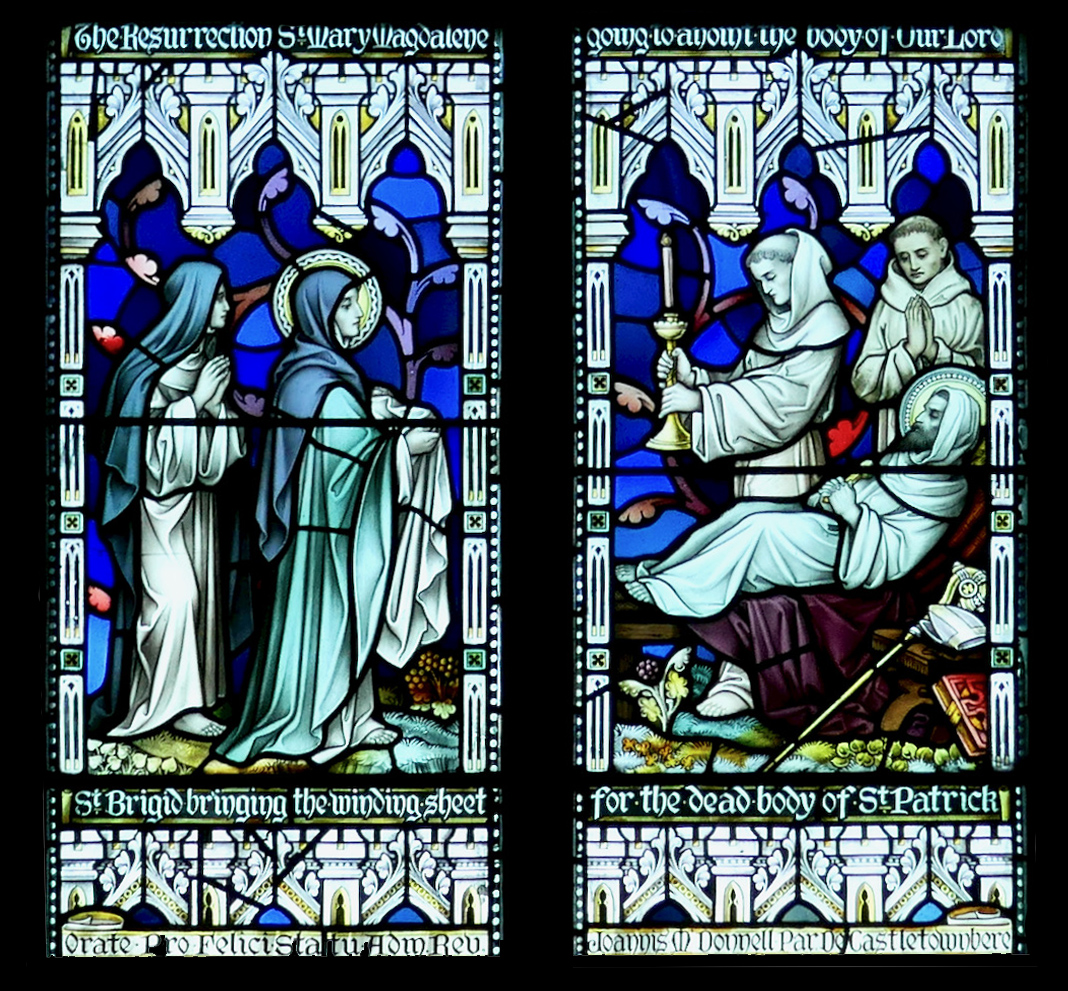
In this window, Brigid brings the winding sheet for the dead St Patrick, a story that does nor feature in either of the Lives I am using here. This is the lower section of a paired window in Killarney Cathedral, part of a series that draws parallels between the Life of Christ and the Lives of Irish Saints. In this case, Brigid is being compared to Mary Magdalene anointing the body of Christ
Many of the same stories occur in both lives. Significantly, though, Patrick is not mentioned in the earlier Life by Cogitosus, although he appears frequently in the Book of Lismore as if she and he were living contemporaneously. There are other differences, showing how the stories grew through the ages, but both agree that Brigid was the daughter of Dubhtach and a bondswoman called Broicsech. Like all good Irish saints, her birth and her greatness is foretold. From the Book of Lismore:
The wizard went to meet him, and asked whose was the woman who was biding in the chariot. Mine, saith Dubthach . . .The wizard asks if she was pregnant by anyone. She is pregnant by me saith Dubthach. Said the wizard, Marvellous will be the child that is in her womb, her like will not be on earth. My wife compels me, saith Dubthach, to sell this bondmaid. Said the wizard, through grace of prophecy, the seed of thy wife shall serve the seed of the bondmaid, for the bondmaid will bring forth a daughter conspicuous, radiant, who will shine like a sun among the stars of heaven. Dubthach was thankful for that answer, for till then no daughter had been born to him.
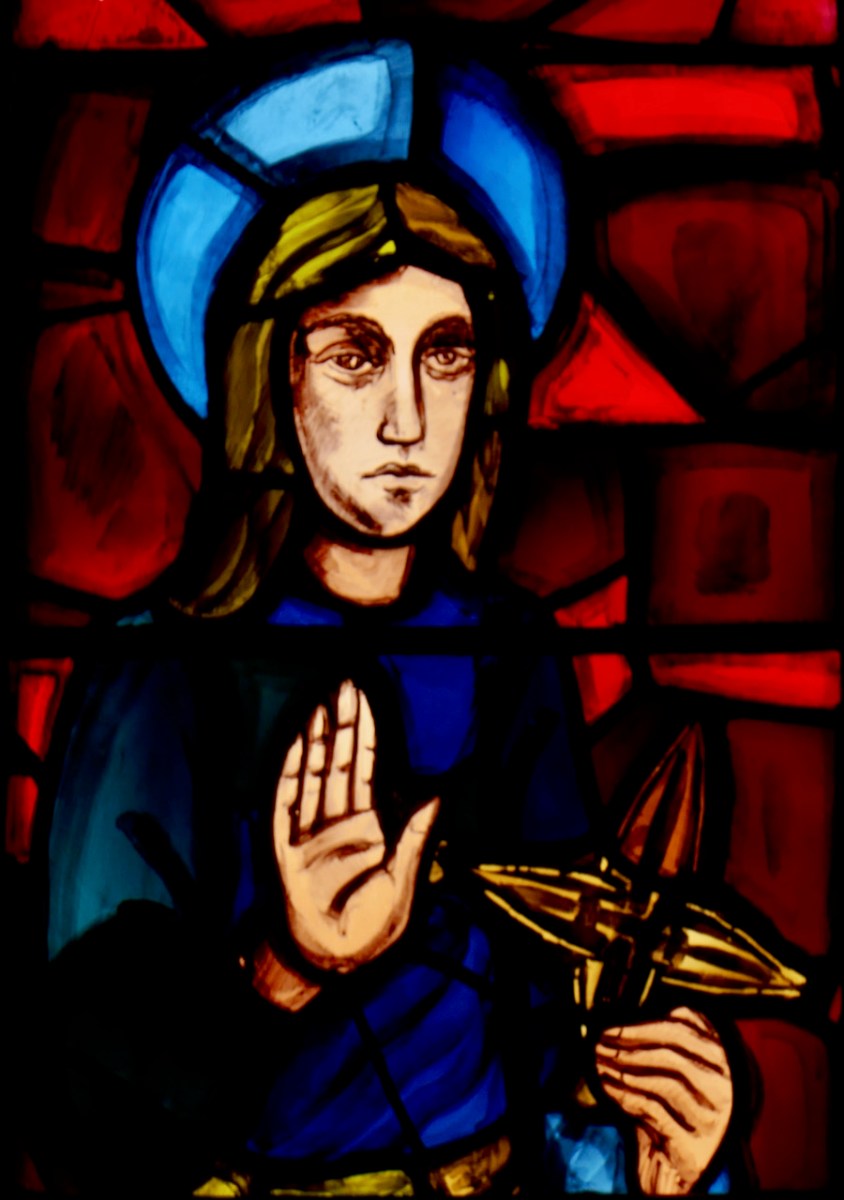
This image of a young Brigid is by Evie Hone and is in Blackrock, Co Dublin. Evie Hone’s windows are pared-to-the-bone, deeply spiritual depictions inspired often by ancient Irish carvings.
I love the fact that Dubhtach rejoices to have a daughter since most of these stories glorify the birth of male babies. Brigid accomplishes many miracles as a child, mostly having to do with her charity and her faith. Here’s one such from Cogitosus:
So, when she was old enough, she was sent by her mother to do the work of churning so that she could make up the butter from the cow’s milk which had been dashed; she too was meant to carry out this work, in the same way as other women were accustomed to do, and to deliver for use the complete yield of the cows and the customary weight and measure of butter at the appointed time with the others. However, this maiden with her most beautiful and generous disposition, preferring to obey God rather than men, distributed the milk and butter liberally to the poor and the guests. So, when as usual the appointed time came for all to hand in what the cows had yielded, her turn came. And when her workmates presented the finished result of their work, the aforementioned blessed maiden was also requested to hand in her work in like manner.
In dread of her mother since she had nothing to show because she had given the lot away to the poor without a thought for the morrow, strengthened and inflamed with an ardor of faith so intense and unquenchable, she turned to the Lord and prayed. Without delay the Lord heard the maiden’s voice and prayers. And, being a helper in the hour of need, he came to her assistance with the generous bestowal of a divine gift, and lavishly restored the butter for the maiden who had confidence in him. Astonishingly, the very moment after her prayer, the most holy maiden proved that she had fulfilled her task by showing that nothing was missing from the fruit of her work, but that it was even more abundant than her workmates.
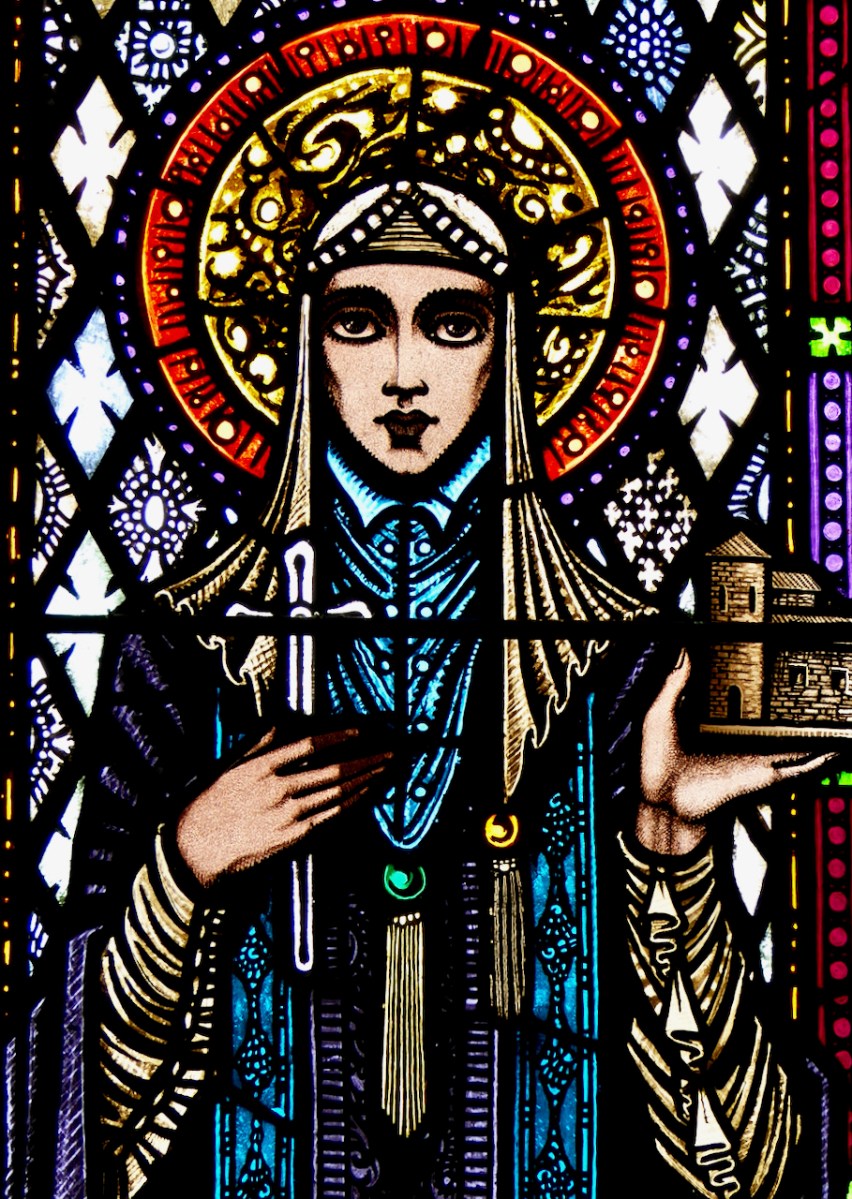
A rather sumptuous Brigid from the Harry Clarke Studios, in Ballinrobe
Eventually, determining to be a virgin and devote her life to God’s work, she took the veil. Cogitosus relates that
Brigit, inspired from above and wanting to devote herself as a chaste virgin to God, went to the most holy bishop MacCaille of blessed memory. Seeing her heavenly desire and modesty and seeing so great a love of chastity in this remarkable maiden, he placed the white veil and white garment over her venerable head.
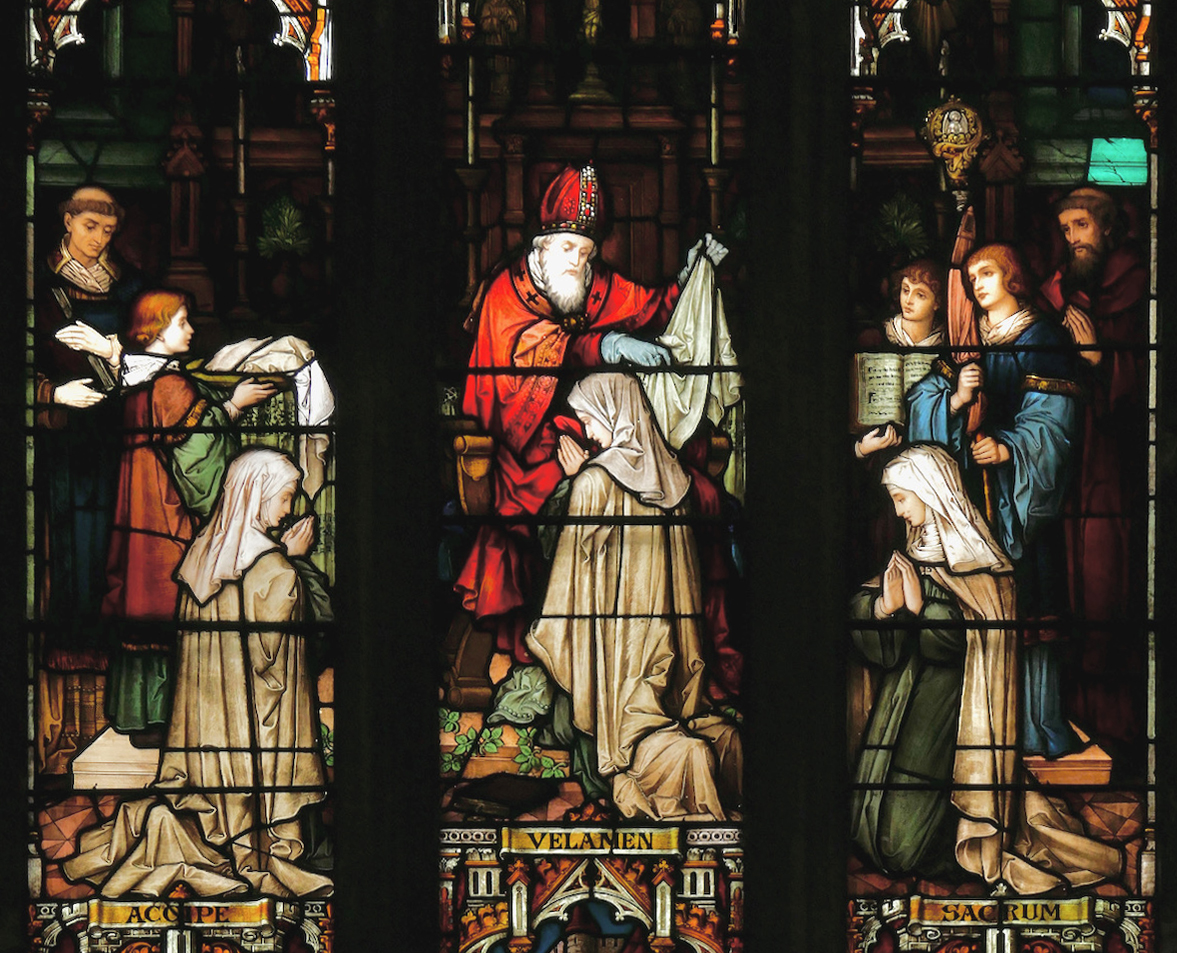
However, by the time the author of the Lismore life wrote his account, MacCaille had been relegated to inferior status and the Bishop who confers the veil is Mel, who is depicted in the window above, in Armagh Cathedral, performing the ceremony. By now, the story has acquired one of its most-quoted aspects – that Brigid, through divine intercession, is actually made a bishop. The next image, the lower panel of the previous window, shows Mel handing Brigid a crozier, symbol of episcopal authority. This large window is by Mayer of Munich.
Brigit and certain virgins along with her went to take the veil from Bishop Mel in Telcha Mide. Blithe was he to see them. For humility Brigit stayed so that she might be the last to whom a veil should be given. A fiery pillar rose from her head to the roof-ridge of the church. Then said Bishop Mel: Come, O Holy Brigit, that a veil may be sained on thy head before the other virgins. It came to pass then, through the grace of the Holy Ghost, that the form of ordaining a Bishop was read out over Brigit. Mac-caille said, that a bishop’s order should not be conferred on a woman. Said Bishop Mel: No power have I in this matter. That dignity hath been given by God unto Brigit, beyond every (other) woman. Wherefore the men of Ireland from that time to this give episcopal honour to Brigit’s successor.
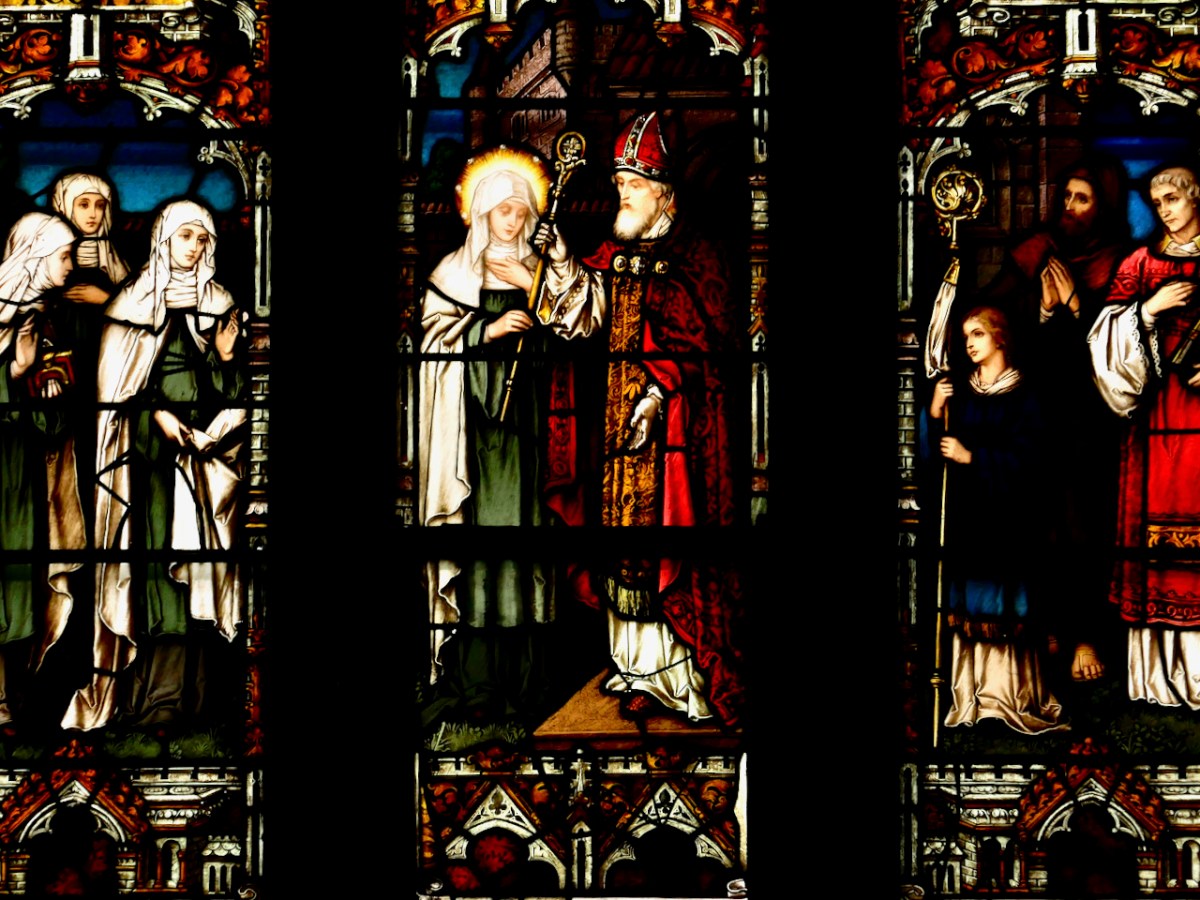
Although she is associated with many places in Ireland (there are numerous townlands called Kilbride or Kilbreedy) it is the great city of Kildare that is most closely hers. She managed the city, the Lismore Life says, in partnership with Conleth, a hermit whom she persuades to join her. Cogitosus tell us:
And as by her wise administration she made provision in every detail for the souls of her people according to the rule, as she vigilantly watched over the Churches attached to her in many provinces and as she reflected that she could not be without a high priest to consecrate churches and confer ecclesiastical orders in them, she sent for Conleth, a famous man and a hermit endowed with every good disposition through whom God wrought many miracles, and calling him from the wilderness and his life of solitude, she set out to meet him, in order that he might govern the Church with her in the office of bishop and that her Churches might lack nothing as regards priestly orders. Thus, from then on the anointed head and primate of all the bishops and the most blessed chief abbess of the virgins governed their primatial Church by means of a mutually happy alliance and by the rudder of all the virtues. By the merits of both, their episcopal and conventual see spread on all sides like a fruitful vine with its growing branches and struck root in the whole island of Ireland. It has always been ruled over in happy succession according to a perpetual rite by the archbishop of the bishops of Ireland and the abbess whom all the abbesses of the Irish revere.

This window by Watsons of Youghal is in St Carthage’s Catholic church in Lismore and is a great example of the Celtic Revival decoration they specialised in. Note the proliferation of oak leaves above her – Kildare is from Cill Dara, meaning Church of the Oakwood, and the oak leaf is one of her attributes, along with the lamp and the crozier, also shown
Cogitosus goes on to say this of Kildare and her establishment (and don’t forget he was writing in or around 650!):
And who can express in words the exceeding beauty of this church and the countless wonders of that monastic city we are speaking of, if one may call it a city since it is not encircled by any surrounding wall. And yet, since numberless people assemble within it and since a city gets its name from the fact that many people congregate there, it is a vast and metropolitan city. In its suburbs, which saint Brigit had marked out by a definite boundary, no human foe or enemy attack is feared; on the contrary, together with all its outlying suburbs it is the safest city of refuge in the whole land of the Irish for all fugitives, and the treasures of kings are kept there; moreover it is looked upon as the most outstanding on account of its illustrious supremacy.
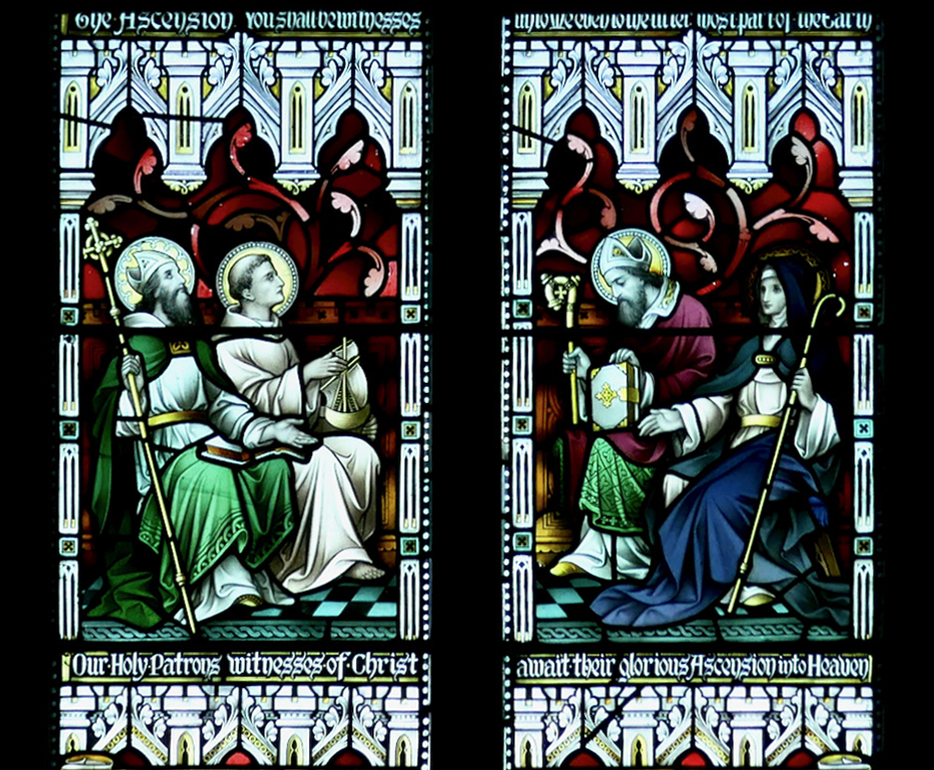
Today we honour St Brigid as one of the founding great women of our culture. She is often shown with Patrick and Columcille as one of the three great Patrons of Ireland. In the window above, also from Killarney Cathedral, Brendan has been added in because, well, we’re in Kerry.
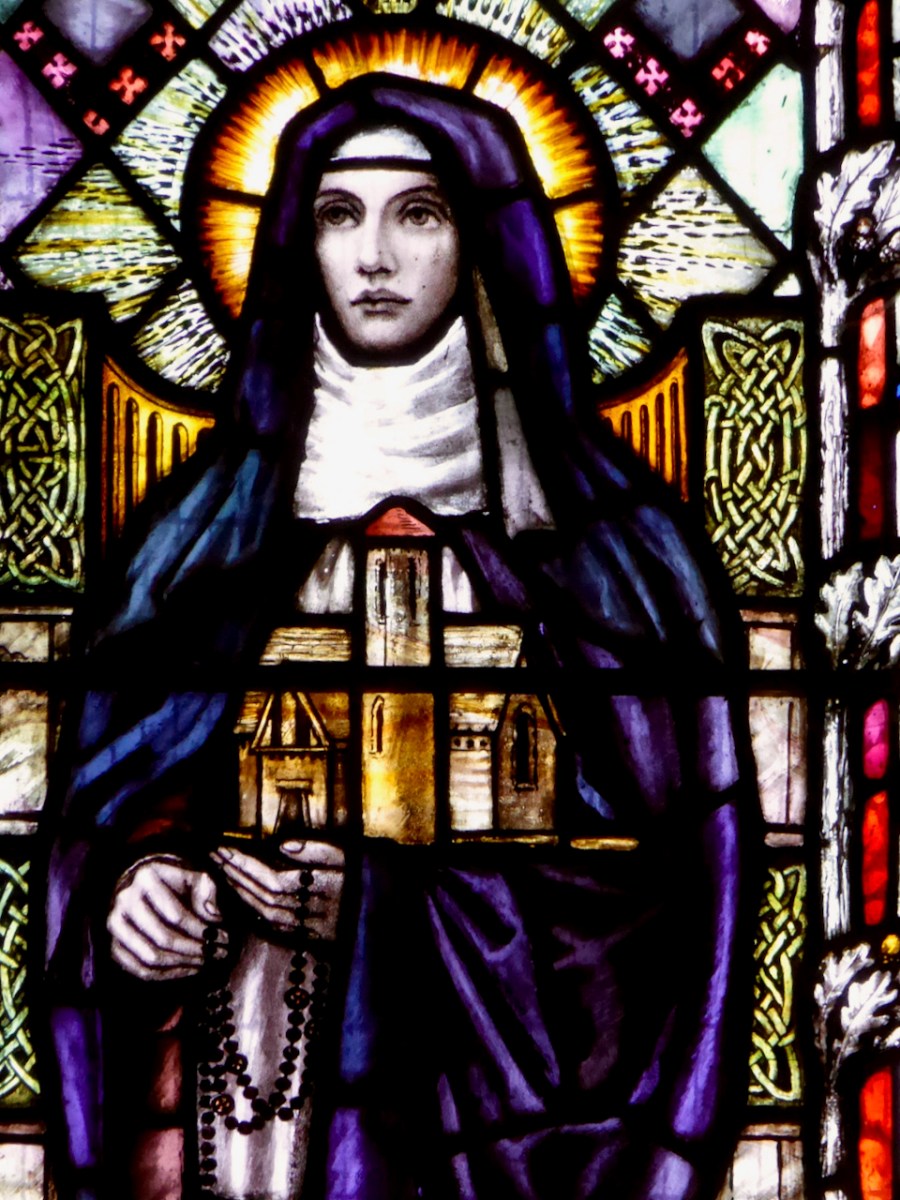
This window is in the Church of the Most Holy Rosary at Kilcoe, near us in West Cork. It’s a bit of a mixed metaphor – we see her holding her church, which is clearly based on the 12th century Cormac’s Chapel at Cashel, and surrounded by her oak leaves. However, she is also holding a set of rosary beads, something that doesn’t appear in Catholic imagery before the 13th century. It’s beautifully executed, though, by Catherine O’Brien of An Túr Gloine.
Brigid’s end was peaceful. As it is related in the Book of Lismore:
Now when it came to the ending days for Brigit, after founding and helping cells and churches and altars in abundance, after miracles and marvels whose number is as the sand of sea, or stars of heaven, after charity and mercy, then came Nindid Pure-hand from Rome of Latium. The reason why he was called Nindid Pure-hand was that he never put his hand to his side, when Brigit repeated a paternoster with him. And he gave communion and sacrifice to Brigit, who sent her spirit to heaven. Her relics are on earth with honour and dignity and primacy, with miracles and marvels.
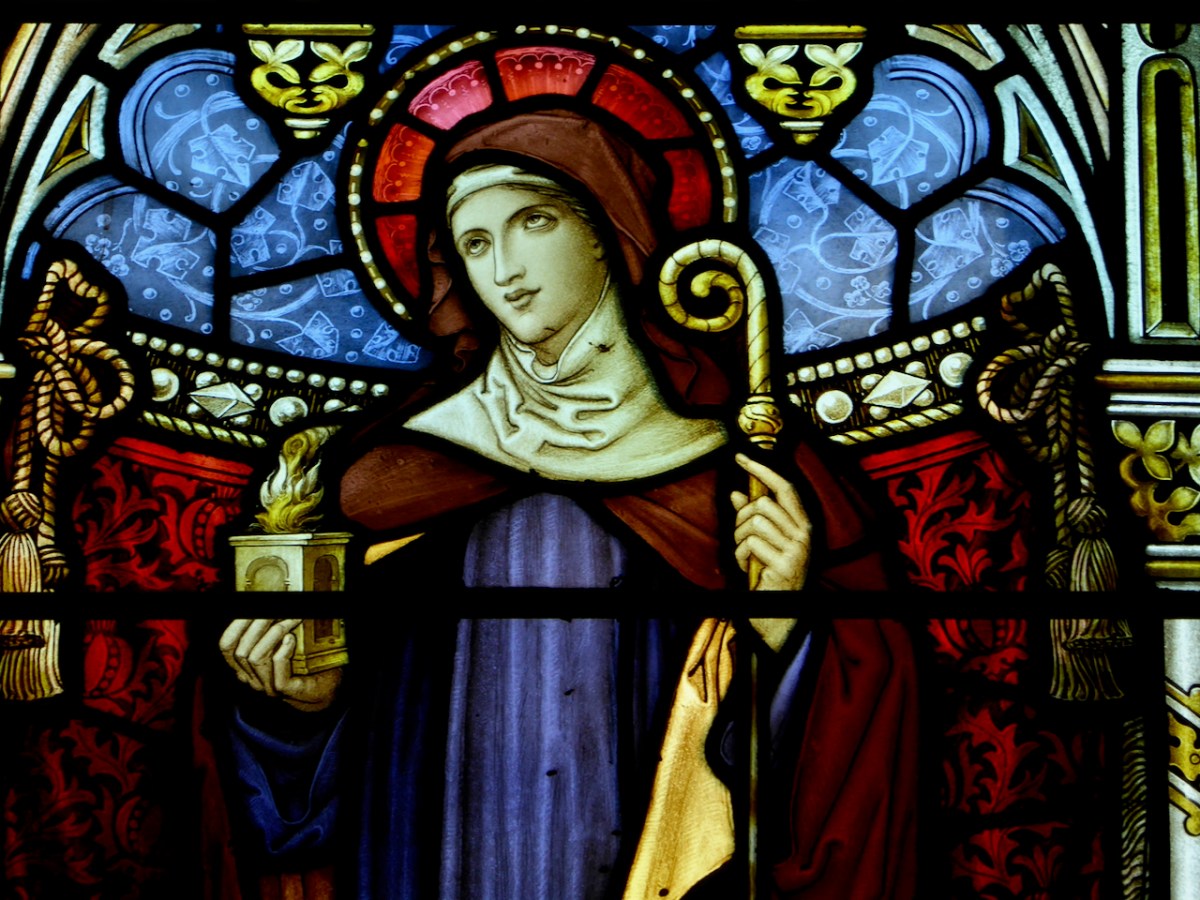
A conventional image of Bridget in the church in Goleen, West Cork, by Watsons of Youghal. She’s looking very saintly indeed. By now, you no doubt recognise all her attributes
Summing up her life and legacy, the anonymous author of her Life in the Book of Lismore says:
For everything that Brigit would ask of the Lord was granted her at once. For this was her desire: to satisfy the poor, to expel every hardship, to spare every miserable man. Now there never hath been anyone more bashful, or more modest, or more gentle, or more humble, or sager, or more harmonious than Brigit. She never washed her hands or her feet, or her head among men. She never looked at the face of a man. She never would speak without blushing. She was abstinent, she was innocent, she was prayerful, she was patient: she was glad in God’ s commandments: she was firm, she was humble, she was forgiving, she was loving: she was a consecrated casket for keeping Christ’s Body and his Blood: she was a temple of God. Her heart and her mind were a throne of rest for the Holy Ghost. She was simple (towards God): she was compassionate towards the wretched: she was splendid in miracles and marvels: wherefore her name among created things is Dove among birds, Vine among trees, Sun among stars. . . . She is the prophetess of Christ: she is the Queen of the South: she is the Mary of the Gael.
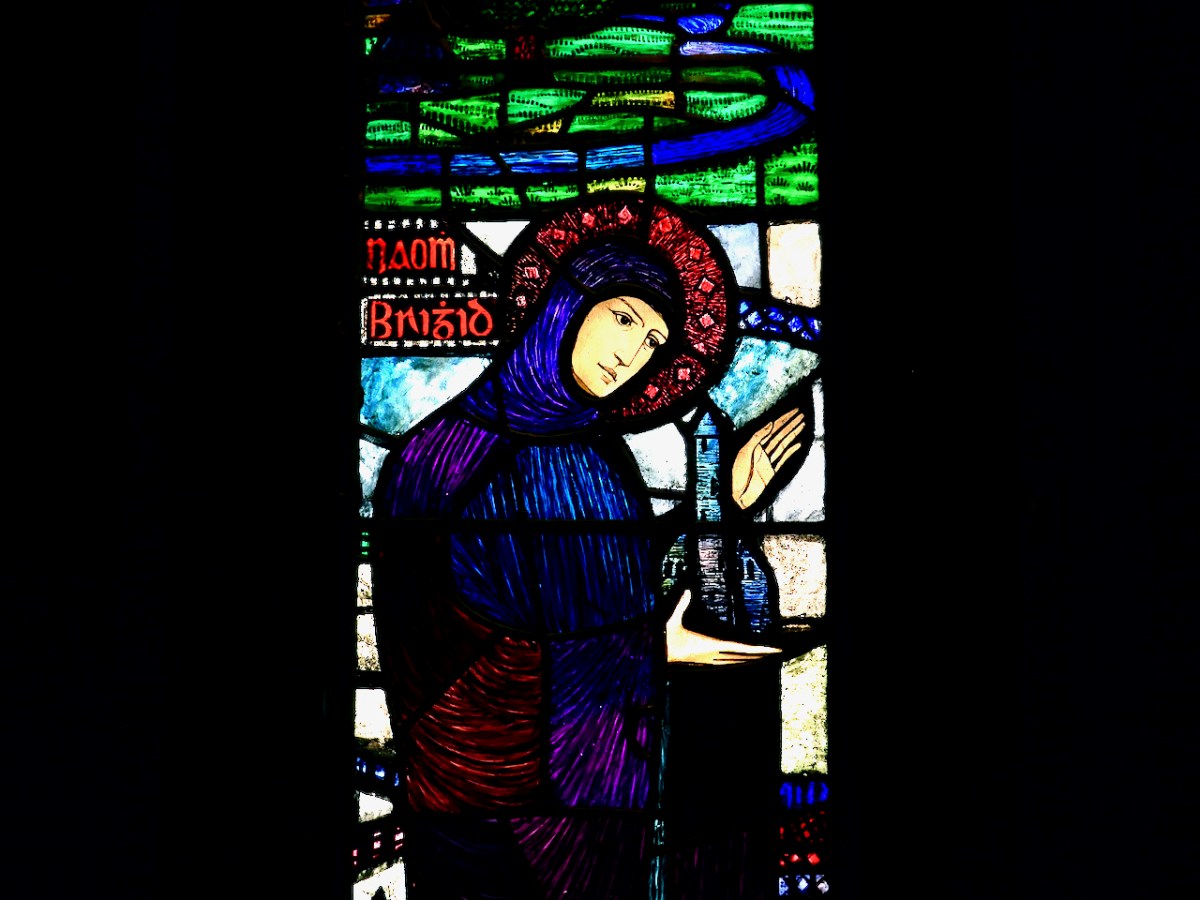
Brigid by Michael Healy, in the stained glass room at the National Gallery, holding her church with the round tower that can still be seen in Kildare.
It is entirely appropriate that a new National Holiday is named for Brigid. About time, in fact!
*Cogitosus’s “Life of St Brigit,” Content and Value. Author(s): Sean Connolly and J.-M. Picard. The Journal of the Royal Society of Antiquaries of Ireland , 1987, Vol. 117, pp. 5-27
**Lives of Saints from the Book of Lismore, Edited with a Translation, Notes and Indices by Whitley Stokes, Oxford, 1890.
Posts about St Brigid
Brigid: A Bishop in All But Name
St Brigid: Dove Among Birds, Vine Among Trees, Sun Among Stars
Wonderful tribute💚🍀💚thank you!
LikeLike
Thank you, Maggie – glad you liked it.
LikeLiked by 1 person
Fabulous post Finola and who could possibly argue the woman is well overdue her own feast day.
LikeLike
Thanks, Roy – glad you approve!
LikeLike
St Brigid’s Day was a significant day in my childhood but that significance has declined over the years – as with most things Catholic! It’s good to see it being revived to? Another day of national drinking?.
LikeLike
I hope not, Paddy. Perhaps Mná na hÉireann can take the lead on it.
LikeLiked by 1 person
Thank you, Fiona, for relating the life and legends of Brigid with wonderful source material and dazzling stained glass images. February 1st has been my first day of Spring for a good many years now, and I am very happy to know it will soon be a national holiday in Ireland!
LikeLike
As are we! Apparently we lag behind other countries in national holidays so this one is overdue.
LikeLike
This is very interesting, thank you, and what a glorious collection of stained glass! I always look forward to St Bride’s Day because of the longer days, so I’m glad you’re going to have a national holiday in her honour!
LikeLike
I think you should lobby the Scottish parliament for the same, Jo!
LikeLiked by 1 person
Sumptuous illustrations to go with the fascinating life – I think we should all rejoice in a few days anyway
LikeLike
Being a favourite image for Irish stained glass, I had a dazzling choice of windows!
LikeLike